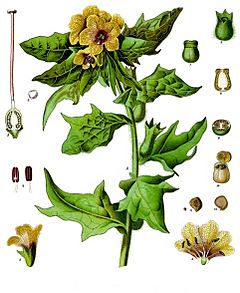Henbane facts for kids
Quick facts for kids Henbane |
|
|---|---|
 |
|
| Henbane | |
| Scientific classification | |
| Kingdom: | |
| Division: | |
| Class: | |
| Order: | |
| Family: | |
| Genus: |
Hyoscyamus
|
| Species: |
H. niger
|
| Binomial name | |
| Hyoscyamus niger |
|
Henbane (Hyoscyamus niger), also known as stinking nightshade, is a plant that belongs to the nightshade family (Solanaceae). It first grew in Eurasia, which includes Europe and Asia. Now, you can find it in many places around the world.
It is very important to know that henbane is a poisonous plant. You should never eat any part of it. Touching it can also cause skin irritation in some people. Always be careful around unknown plants.
Contents
What is Henbane?
Henbane is a plant that can grow to be quite tall, sometimes up to 1.5 meters (about 5 feet) high. It has sticky, hairy leaves and a strong, unpleasant smell. This is why it is sometimes called "stinking nightshade."
Where Henbane Grows
This plant likes to grow in dry, sunny places. You might find it in fields, along roadsides, or in waste areas. It is common in parts of Europe, Asia, and North Africa. It has also spread to other continents.
What Henbane Looks Like
Henbane plants have soft, sticky hairs all over their stems and leaves. The leaves are large and have wavy edges. Its flowers are usually a pale yellow or greenish-yellow color. They often have dark purple veins, which makes them look quite striking. The flowers grow in clusters.
After the flowers bloom, the plant produces small, capsule-like fruits. These fruits contain many tiny seeds. The seeds are also very poisonous.
Life Cycle of Henbane
Henbane can be an annual or biennial plant. This means it can complete its life cycle in one year or two years.
- Annual Henbane: These plants grow from a seed, flower, produce seeds, and then die all within one growing season.
- Biennial Henbane: These plants grow leaves and roots in their first year. In the second year, they grow a tall stem, flower, produce seeds, and then die.
Reproduction of Henbane
Henbane reproduces through its seeds. The plant produces many seeds, which can be spread by wind, animals, or human activity. These seeds can stay in the soil for a long time before they sprout. This helps the plant spread to new areas.
Historical Uses (with caution!)
For a very long time, people have known about henbane. In ancient times, it was sometimes used in traditional medicine. However, because it is so poisonous, using it was very dangerous. It was also sometimes used in old rituals, but again, this was extremely risky.
Important: Even though it was used in the past, henbane is not safe to use today. Modern medicine has much safer and more effective treatments. Never try to use henbane for any purpose.
Images for kids
See also
 In Spanish: Beleño negro para niños
In Spanish: Beleño negro para niños








